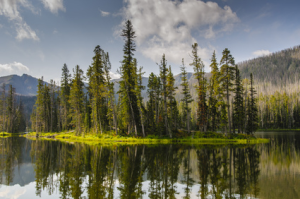
Forest in Yellowstone National Park
Dr. Chengquan Huang is a Research Professor in the University of Maryland’s Geographical Sciences Department. This afternoon at the 2015 AGU Fall Meeting, Dr. Huang presented a poster explaining where to find U.S. forests that have been undisturbed for last 25 years. His research relied on Landsat to both find these forests and understand forest disturbance trends in the U.S.


Figure 1. High concentrations of undisturbed forests are distributed mostly in the northeast, north central, and western U.S., often along ecoregion boundaries. Image credit: Huang et al.
Presentation title:Where are the forests in the United States “not disturbed” over a quarter century?

What insight did you gain from Landsat that would have been impossible to glean otherwise?
What are the major implications of your findings?

Figure 2. Percent forest remaining undisturbed (PFUD) within a time interval decreased following an exponential decay function in the conterminous U.S. and each of its four regions as the time interval increased. Image credit: Huang et al.
- About 1.7 million square kilometers, or two thirds of 2.6 million square kilometers of forest in the conterminous U.S. did not experience any detectable natural or anthropogenic disturbance during the quarter century between 1986 and 2010 (see figure 1)
- The northern states in the eastern U.S. have the highest percentage of forest remaining undisturbed, while those in the south have the lowest values
- At any given time interval, the percentage of forest remaining undisturbed decreases following an exponential decay function as the time interval increases (see figure 2)
- If forest disturbance rates remain relatively stable over time, the conterminous U.S. would have less than 20% forest remaining undisturbed in 100 years, which would become less than 4% in 200 years
- Management approaches aimed at reducing timber harvest rates in the south and mitigating fire risks in the west are needed in order to maintain higher levels of undisturbed forests.
What insight did you gain from Landsat that would have been impossible to glean otherwise?
- Without Landsat, we wouldn’t be able quantify the amount of forest undisturbed over multiple decades at local, regional, state, and national scales;
- We wouldn’t be able to reveal that the percentage of forest remaining undisturbed at any given time interval decreases following an exponential decay function as the time interval increases, and therefore wouldn’t be able to estimate how much forest would remain undisturbed over multiple centuries.
What are the major implications of your findings?
- Old growth forests (> 100-200 years): mostly in the north and west, very little in the south, may constrain the distribution of species that favor old growth forests;
- Forest carbon stock: because old growth forests typically have higher carbon density than young forests, the south have more potential to increase its forest carbon stock than other forested regions in conterminous U.S.;
- Management approaches aimed at reducing timber harvest rates in the south and mitigating fire risks in the west are needed in order to increase and maintain higher levels of undisturbed forests.
Source: NASA/Lansat images

Δεν υπάρχουν σχόλια:
Δημοσίευση σχολίου